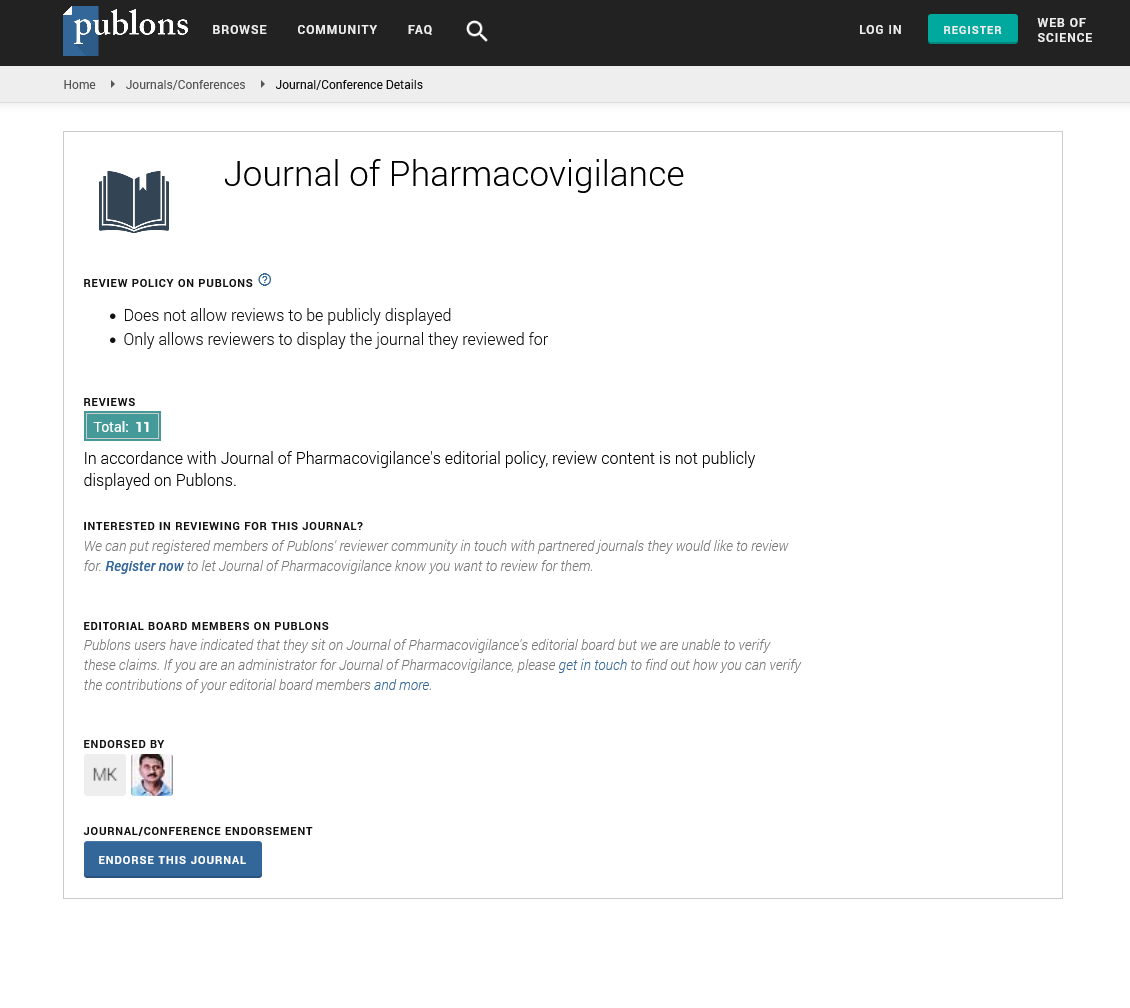Indexed In
- Open J Gate
- JournalTOCs
- The Global Impact Factor (GIF)
- RefSeek
- Hamdard University
- EBSCO A-Z
- OCLC- WorldCat
- Publons
- Euro Pub
- Google Scholar
Useful Links
Share This Page
Journal Flyer

Open Access Journals
- Agri and Aquaculture
- Biochemistry
- Bioinformatics & Systems Biology
- Business & Management
- Chemistry
- Clinical Sciences
- Engineering
- Food & Nutrition
- General Science
- Genetics & Molecular Biology
- Immunology & Microbiology
- Medical Sciences
- Neuroscience & Psychology
- Nursing & Health Care
- Pharmaceutical Sciences
Perspective - (2024) Volume 12, Issue 2
Mitigating Public Health Risks: A Pharmacovigilance Approach to Counterfeit Drugs
Yamamoto Kojiro*Received: 29-May-2024, Manuscript No. JP-24-25987; Editor assigned: 31-May-2024, Pre QC No. JP-24-25987 (PQ); Reviewed: 14-Jun-2024, QC No. JP-24-25987; Revised: 21-Jun-2024, Manuscript No. JP-24-25987 (R); Published: 28-Jun-2024, DOI: 10.35248/2329-6887.24.12.480
About the Study
Counterfeit drugs infiltrate the global pharmaceutical market, jeopardizing public health through adverse effects, treatment failures, and even fatalities. Pharmacovigilance, the science of drug safety monitoring, offers a strategic approach to combat this threat. This manuscript explores the public health risks associated with counterfeit medications and outlines a pharmacovigilance-based strategy to mitigate them.
The presence of counterfeit drugs within the global pharmaceutical landscape poses a significant and growing public health concern. These illicit medications deliberately mimic legitimate drugs in packaging, labeling, or ingredients. They may contain harmful contaminants, incorrect dosages, or lack any active ingredients altogether. The World Health Organization (WHO) estimates that one in ten medical products circulating in low- and middle-income countries is counterfeit. These drugs pose a multifaceted threat, leading to:
Counterfeit drugs can contain unknown substances or incorrect dosages, triggering unpredictable and potentially severe ADRs in patients. The absence of effective ingredients in counterfeit medications renders them useless against serious conditions like malaria or HIV/AIDS, allowing the disease to progress unchecked. Counterfeit antibiotics with incorrect dosages or ineffective ingredients can contribute to the rise of antimicrobial resistance, a global health threat with dire consequences.
Role of pharmacovigilance
Pharmacovigilance, the science and practice of monitoring the safety of medicines, serves as a critical safeguard against counterfeit drugs. By actively monitoring drug use and collecting data on ADRs, pharmacovigilance plays a pivotal role in protecting public health from these illicit medications.
A comprehensive pharmacovigilance strategy can be implemented to mitigate the public health risks associated with counterfeit drugs. This strategy should focus on the following key areas:
• Strong systems for reporting suspected counterfeit drugs are essential. Pharmacovigilance programs should actively encourage healthcare professionals and the public to report suspected counterfeits to the relevant authorities. This allows for swift investigation and potential product recalls, minimizing harm.
• Raising public awareness about the dangers of counterfeit drugs is crucial. Educational campaigns can inform people about identifying legitimate medications, including physical characteristics of packaging and labeling. Additionally, highlighting the importance of purchasing drugs only from authorized sources, such as licensed pharmacies, empowers individuals to make informed healthcare decisions.
• Integrating technologies like serialization and track-and-trace systems can significantly enhance drug authentication throughout the supply chain. These technologies assign unique identifiers to individual medication packages, allowing for verification of their legitimacy at every stage, from manufacturing to dispensing.
• Combating the global menace of counterfeit drugs requires a unified front. Strengthening collaboration between regulatory agencies, law enforcement bodies, and the pharmaceutical industry is vital for effective enforcement and information sharing. Collaborative efforts can facilitate coordinated investigations, dismantle counterfeit drug networks, and share best practices for pharmacovigilance programs.
Conclusion
Counterfeit drugs pose a serious threat to public health, jeopardizing patient safety and undermining trust in the healthcare system. A strong pharmacovigilance program that incorporates strengthened surveillance, public education, drug authentication measures, and international collaboration is critical to mitigate these risks and ensure the safety and efficacy of the global medication supply.
Citation: Kojiro Y (2024) Mitigating Public Health Risks: A Pharmacovigilance Approach to Counterfeit Drugs. J Pharmacovigil. 12:480.
Copyright: © 2024 Kojiro Y. This is an open-access article distributed under the terms of the Creative Commons Attribution License, which permits unrestricted use, distribution, and reproduction in any medium, provided the original author and source are credited.

